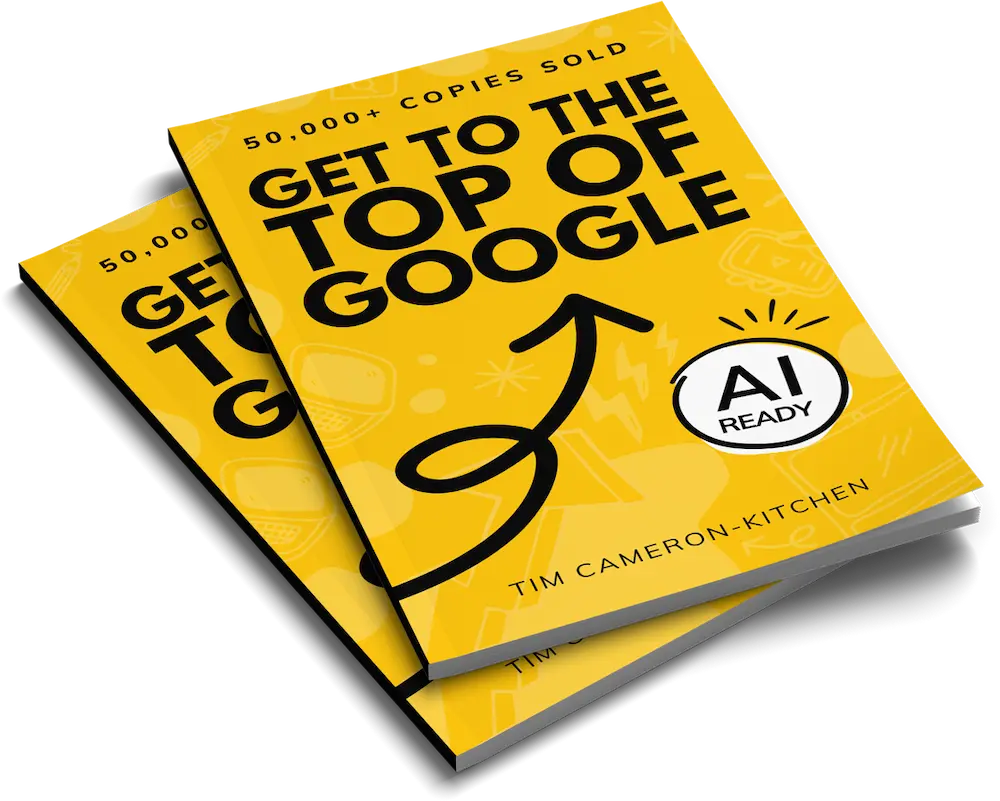
Get Weekly Marketing Tips
Join 30,000+ marketers and get the best marketing tips every week in your inbox
Transcript
Marketers are confused. I mean, some people say it doesn’t take a lot, but I think in this case we are justified in being confused. Is AI-written content going to get our website banned from Google? Is AI content rankable? Is it actually useful for a marketing purpose or not?
Well, in today’s episode, we are gonna look at how Google has flip-flopped on this policy over the last couple of years and what Google’s stance is today and moving forward on whether or not you can publish AI content on your website, use it to get ranking, or whether it’s gonna get you banned. Let’s do this.
Welcome to the Thinkplus Digital Marketing Podcast. My name is Tim Cameron Kitchen. I’m a bestselling digital marketing author, Head Ninja at Thinkplus – we are a digital marketing agency. We help our clients get more leads in sales through their websites, and that’s exactly what this podcast is all about.
Now, as you may know, we talk a lot about SEO on this podcast because it’s such a fantastic way of driving traffic and sales to pretty much any business. And one massive component of SEO is content and the content that you publish on your website.
Obviously with ChatGPT and various language models that have come to prominence in the last few months, one of the big questions is how us marketers can use AI to write content which we publish on our websites.
And one of the huge questions we have on this topic is whether it can actually get ranking, and if it can get ranking, great, but will that ranking maintain or will it get our site banned?
Now, back in August 2022, Google released the Helpful Content Update, which was one of the most talked about ranking or algorithm updates of recent times because, for the first time in a long time, Google was talking about possible site-wide penalties for sites that failed to meet the helpful content standard. In other words, if you published unhelpful content or content that it didn’t deem helpful, then your entire site could see a drop in ranking.
So lots of SEOs and marketers took this update really seriously, and in particular, there was one line in there that said, “Content must be written by people for people”. Now, a lot of us took that to be pretty straightforward, saying you cannot publish AI-written content because AI-written content isn’t written by people.
Why else would you say that? If it’s not written by people, then obviously it’s written by AI, presumably, because the only other options would be dogs or monkeys or something. They’re not writing the sort of content that tends to get ranking on Google. We’ve tried. They just can’t do it. Their paws are too big and their brains are too small.
So obviously a lot of us took that to mean you can’t publish AI-written content, but actually it’s not that simple.
And the video version of this, I think we’re gonna call “Google’s AI flip flop” because you can see how Google’s policy has changed over recent times, which has obviously left many people confused.
The good news is they do seem to have a pretty consistent stance on this now, but I think it’s important that before you start publishing AI content on your site, you understand the history and where this has all come from because we are talking about fairly big levers here and fairly big penalties for getting this wrong.
Now, way back in 2017, Google said during its annual developer conference that they’d be moving from a mobile-first world to an AI-first world. This is a pretty big statement – back in 2017 that was not as evident as it is in 2023. So Google was really on the front foot here, very early, invested in DeepMind, I think in 2015, so they were very early in the world of AI, and they’ve been using AI for a long time in their search results.
So it appeared at that point that, “Okay, Google is very pro AI and they’re gonna be encouraging marketers to use it”, but actually since then, they’ve mostly taken a negative stance towards website owners publishing AI content.
In fact, up until April 2022, Google’s webmaster guidelines actually said, – and I’m gonna quote you here to make sure I get it right – it says, section of webmaster guidelines.
By the way, this page isn’t published on the webmaster guidelines anymore, but you can see a version on the Wayback Machine. So if you want to go and watch the video version of this on our YouTube channel, you’ll see it there.
Google says there’s a section titled, “Specific Guidelines”, and it says, to avoid, in bold, the following techniques.
The number one technique to avoid is automatically generated content. Okay? That was up until April 2022. I’m looking at a version from or, or even early May, 2020. Oh, no, yeah, early April 2022 said “Avoid automatically generated content”, so, okay.
Pretty straightforward. Publishing AI content is against Google’s guidelines. Not quite that simple. By the end of May, they’d updated the wording to say, “Avoid the following techniques, automatically generated content, intended to manipulate search rankings.” Now “intended to manipulate search rankings” is Google’s sort of catchall phrase that they use for anything that they don’t like, which is difficult to say categorically that you’re not allowed to do it.
Okay. So anything that you are doing on your website really that is intended to manipulate search rankings, Google reserves the right to say it’s bad, despite the fact that most, you know, a huge amount of the attention that goes into building and designing and writing and optimising a website is basically intended to manipulate search rankings because we wanna get our websites shown, as SEO’s intention is to manipulate search rankings.
But anyway, they’ve added that caveat, so, at that point, people are thinking, “Right, great, okay, so we can publish, as long as it’s not intended to manipulate search rankings, we can publish AI-written content.” Again, not so. Google’s John Mueller also labelled AI-written content as spam. He actually calls it spam in one of their Google Search Central SEO Hangouts.
That was on the 1st of April, 2022. It had a huge amount of attention in the SEO world. Lots of people saying, right, that is it. That is categorical, no AI-published content on the website. Then we’ve got the Helpful Content Update in August 2022 saying, “helpful content written by people for people” again.
Right. Okay. It is clear Google doesn’t like AI-written content. But then Danny Sullivan clarified on Twitter. Danny Sullivan is Google’s search liaison, so he’s like the person who interfaces with the SEO world, really him and John Mueller, the interface with the SEO world to answer questions that we’ve got about how Google works and stuff like this.
Danny Sullivan says on Twitter, “We haven’t said that AI content is bad. We’ve said pretty clearly content written primarily for search engines rather than humans is the issue.” Well, mate, you literally said AI content is bad. One of the Google employees has said it’s spam, it’s pretty bad. And then the Webmaster Guidelines have said, avoid it otherwise you’re not gonna rank.
So pretty clearly you said it’s spam, but here we can see the confusion. This is where a lot of the confusion comes from because one person will say one thing, and another person will say another thing. Then of course, in November 2022, we’ve got ChatGPT coming out, and that’s really shaken things up.
Very, very clear that this is the future of content generation, even if the technology isn’t there yet. These tools are incredibly powerful to help content writers, and it’s clear that more and more content will become AI written. So Google then updates in 2023 in one of the developer blogs to say, “Our focus is on the quality of content rather than how content is produced.”
And by the way, I think this is the only viable long-term stance that they can take. Anyway, continuing, it says, “When it comes to automatically generated content, our guidance has been consistent for years.” Mate. No, it hasn’t. It’s changed twice in the last year. But anyway, “using automation, including AI to generate content with the primary purpose of manipulating ranking and search results is a violation of our spam policies.”
“That this said, it’s important to recognize that not all use of automation, including AI generation is spam.” Okay? That’s contrary to what John said, less than a year ago. “AI has the ability to power new levels of expression and creativity and to serve as critical tools to help people create great content for the web.”
Okay, so that is Google’s policy today. That it doesn’t matter how the content is produced, as long as it is good quality, you are gonna be okay. And I think the reason I think this is the only viable approach that they can take long term is that it’s very clear that even open AI’s own AI detection software was accurate 43% of the time, right?
43% of the time it could detect content that was written by Open AI’s own tools. Okay? So all of these AI detection tools are fundamentally flawed. You can get around most of them by saying things like, vary your sentence length and including odd phrases to make it sound more human. And all of a sudden content purely published by AI, you know gets a hundred percent human certainty scores.
So the reality is that even if it can detect AI-written content now, there’s gonna be a time when that is not the case. And even if it thinks it has AI-written content, can it be so sure as to levy a sitewide penalty on that content on that website for a detection scheme that is potentially incredibly flawed and has a very low, certainty? Unlikely that they can make algorithmic ranking decisions based on something that is so difficult to detect.
So I think it’s the only viable long-term stance Google can take is that it doesn’t matter where the content comes from, whether it’s AI or not, it’s all about the quality. Now, this actually ties in with everything that we’ve seen about AI-written content. There’s loads of hype about, “Hey, you know, we published all this AI content and it ranked for a little bit, and then the rankings were slashed” if you go and look at the content that they’re referring to it’s junk.
So let’s talk about how to create AI content that does fit with Google’s guidelines.
By the way at the moment, I’m recording this in mid-April 2023, you can’t put out content that’s only been generated by AI with no human intervention and expect it to rank. That is our professional opinion. The content that we’ve seen and that we’ve been experimenting with and playing with on the latest large language models that we’ve got access to GPT-4 four and ChatGPT using GPT-4.
That content we don’t believe is sufficient to rank, get engagement and get conversions. It still reads a little bit AI-y, which we’re gonna come back to later on. We’ve also seen lots of, there was a Neil Patel tweet or a tweet that featured Neil Patel, where he’d reported that I think they’ve got half of their websites they publish just pure AI junk and then half of Neil’s websites, they publish AI content that has sort of human editing, and he reported that after the Helpful Content Update, the websites that had seen most of their content generated by AI saw a 17% drop in organic traffic and a 7.9 position average drop in search rankings. This was much higher than sites that used AI content with human intervention or fully human-written content.
Well, this makes total sense because if you think about, you know, after the helpful content update, which was August 2022, the quality of AI written pure AI written content was utter trash. It reads like AI content it is very generic, it’s very linear. It has this sort of linear feel to it, which is difficult to describe, but if you think about how a large language model works, what happens is they sort of come up with the next section of text and then the next section of text, and then the next section of text and then the next section of text.
So when a human plans an article, we tend to think in a much more, you know, a much more structured way. There tends to be an arc to it. So we’ll plan out different topics. We’ll plan out what we want to say, we’ll put the key messages in certain places. We’ll build up to those messages, and then we’ll add in a new point. And it reads much more engaging.
If you read the writing of a professional writer, professional content market, it can be so engaging even about potentially very dry topics.
If you read content from even the most up-to-date large language models, typically it feels very difficult to process. It feels very generic and very boring to read, and that’s a really big issue because if it’s boring to read, humans who read it aren’t gonna be staying very long on your website, they’re gonna be leaving and when they leave, your rankings are also gonna leave as well.
So it is no good just publishing pure AI stuff, even if it’s from GPT-4 or ChatGPT using GPT-4. There’s plenty that you can do to make it usable. It’s an incredible tool. We use it all the time in our content team as well. Not all the time, but a lot of the time in our content team. But just publishing pure AI stuff isn’t great.
For example, some of the ways that we use it, we use it to help us with research. So if we’re getting up to date on a particular topic, even if it’s an in-depth topic for a business which is fairly sort of niche or fairly specific, it can be a great way to get up to speed to understand some of the different perspectives from that industry and what’s going on, so we can identify what an interesting story angle could be.
It can also be really useful to help you create outlines. Thinking through all of the different topics that sit under a topic, right? Thinking of all the subtopics that sit under a topic, working out what the headlines are gonna be working out, all that type of stuff. You can even use it to create individual paragraphs as well, although these will often need editing because we’ll need to fit them into the wider article. If you read an article that’s just been written, sort of paragraph by paragraph, with each one being individual entities, it’s incredibly boring and incredibly difficult to process. So, you know, not ideal, but you can use it and then use a human to sort of join them up together.
Think of it like building a wall, right? You’ve got these individual bricks, but then you’ve gotta shape the wall. You’ve gotta put the mortar in between them. You’ve gotta make sure they’re all lined up. That’s really important human work at the moment. At the moment – I’m sure AI will figure it out, but at the moment it’s there.
So you can get the most from AI by using and, and asking it for individual questions about a topic and then using those answers to form your content instead of just saying, “Hey, write me an article on whatever Google’s stance is on AI. You’re gonna get some absolute trash from that. But if you use it in a bit more of an investigative and collaborative way, you get some really great stuff from it.
There was an article I saw recently by David Sacks, who’s a sort of a software, investor. And this got a lot of attention because he used GPT-4 in a really sort of creative way to collaborate on an article as if it was a researcher.
So it starts with – he wanted to write a blog post. So the blog post was the output, but the way that he went about it was much more creative than just, “Hey, write me an article on this blog post.” So he starts off by asking GPT-4, is it familiar with a particular technology startup, that was acquired by Salesforce? And can GPT provide a detailed summary of its company history? Now he’s doing this to make sure that it understands the topic because it’s got a knowledge cut off and stuff like that.
He then clarifies and says, okay, great. That’s the correct company. Can you tell me more about its unique crowdsourced approach to collecting and maintaining data, and which other companies have used a similar approach?
So here he’s starting to use it almost as a researcher to go and identify – he had an idea for this article, but he didn’t know if it was viable yet, so he used it as a researcher to go find it, and it basically did exactly that. So it identified the key points about this business’s data model, and then went and found some other companies that met these criteria.
So he then asks, “Do you think that this crowdsourced approach to data collection could work for an AI startup?” Gives it a bit more detail and then ChatGPT says, “Yep, actually, I think it could work.”
And you’ll notice that these GPT models are really good at reasoning. I actually think their reasoning capabilities are, are more newsworthy than their content-creating capabilities. Very, very powerful at reasoning. And it says basically, “Yes, that could work” and gives a few reasons and, and examples of why that could work. Then he asks for a bit more detail. It gives a bit more detail, and so on and so on. So he then says, can you turn these findings into a table? Gives it a bit of detail about what the table should include. It does it, he then asks it for more categories and asks it to give more detail on the table. It does it.
Then finally he says, okay, can you help me write a blog post summarizing everything that we’ve talked about? So, He sort of educated this particular chat. Remember ChatGPT doesn’t have a memory, but it does have a memory of that conversation, so he’s sort of gone through the whole research process earlier in the conversation so that it’s now really well informed and it can use all the prior information as it’s gathered to write a much more informed article than if he just sends it off on its own.
He has to clarify and they go through a whole bunch of different iterations and he points out particular sections that he doesn’t really like and gets it to, you know, flesh those out a bit more or change angle on it. He keeps on refining and refining until he is happy with it. So this is a very, very long conversation.
It’s, I don’t know, 50, I don’t know how many page scrolls it is. It’s probably 30-50 page scrolls, so it’s a really long conversation. But what he’s ended up with is actually a very unique perspective on something which is not what you’d typically expect from an AI-generated article. This isn’t the sort of thing that you get from ChatGPT without a lot of human massage if you like.
We’re also seeing some fascinating examples inside Thinkplus with our content team who are creating or testing, creating sort of, writing collaboration workshops. Actually, let me just talk you through a specific example. It’s gonna be easier to understand. So one of our writers started off by wanting to write a comic script and he wanted to make this comic script funny.
So what he did was give chat GPT descriptions of particular, comedy writers, right? Talking about what they’ve done before their style, what they’re known for, that type of thing. So he’s sort of programming the chat first with these individual people. He then asked it to run a sort of round table where these people, these individual characters bounce round ideas for, comics and bounce round ideas for the story arc and stuff like that.
And then once he’s got that, then goes through the process of having them create the actual like frame by frame description of what happens in this comic. And the output was so much better than if he just said, “Hey, write me a comic about something.” And then it would just be like total generic garbage.
But because he’s sort of taken the time to program it and be a bit more creative with the prompting, you get a much better output. So that seems to be where things are going, and that type of content is incredibly rankable because actually what we’re talking about here, is taking human creativity and human expertise and enhancing it even further with AI.
So the sort of content that we’re producing with this type of approach is way better than a human can write on its own. So it makes sense that Google would want to reward this type of content, not punish it, because it’s actually better than what we were able to produce previously.
So there you have it. Google seems to be pro AI as long as the content is really good. If it’s rubbish, it’s not gonna get ranked anyway, and you’ve gotta think about helpful content and that threat of a site-wide penalty. If you wanna learn more about creating AI content, then we’ve got some other podcasts and other videos on our YouTube channel, which you can check out.
Before we go, I also want to suggest if you need some help with your digital marketing, the team here at Thinkplus have a free website and marketing review, which we offer to people, and we basically have a look at your website, the digital marketing that you’re doing at the moment. We ask you for your goals, your business goals for the next 12 months.
We then put together a plan based on what you’ve done currently, what the opportunity is in your space, and what your competitors are doing to hit those goals within that 12-month period, which you can then go and implement yourself, or you can work with an agency or you can ask for our help if you need as well.
So to get this free website, a marketing review, go to exposureninja.com/review. That’s exposureninja.com/review. It is totally free. There’s no catch. If we identify when we’re doing our research that actually, the free review isn’t gonna be the most useful thing for you and there’s something else more useful that we can give you, for example, a course or some specific training for one of the issues that we might identify to be a growth blocker for you, then we might send you that instead. But either way, go to Thinkplus.com/review to request your free review and we will send you free stuff that will help.
Until next week, see you soon.
Timestamps
00:00 – Google’s changing stance on AI
05:42 – How to make AI content that ranks on Google
Related Links
- Search Engine Journal
- SEO AI
- Helpful Content Update
- ChatGPT: New AI chatbot has everyone talking to it
- What is the AI chatbot phenomenon ChatGPT and could it replace humans?
- ChatGPT is fluent, clever and dangerously creative
- Google Search’s guidance about AI-generated content
- Neil Patel – Google’s Spam Update Just Completed: Here’s What Happened
- The Give-to-Get Model for AI Startups by David Sacks




















